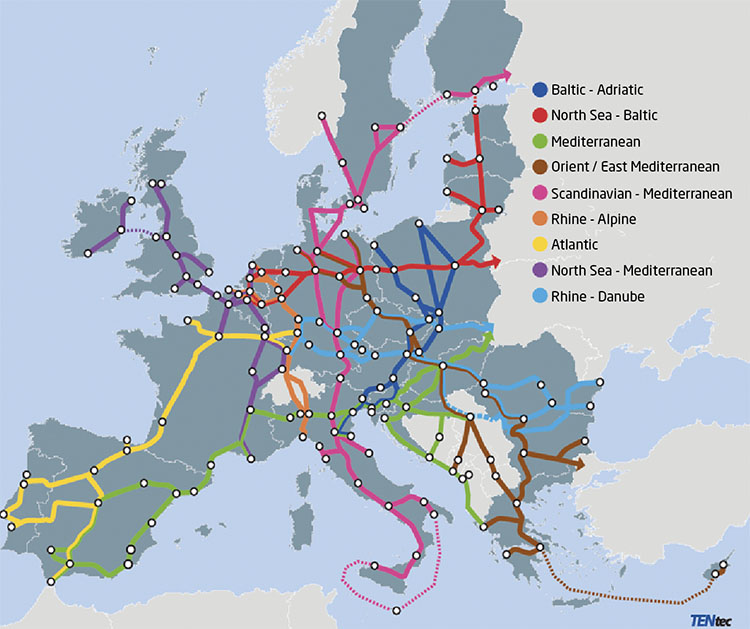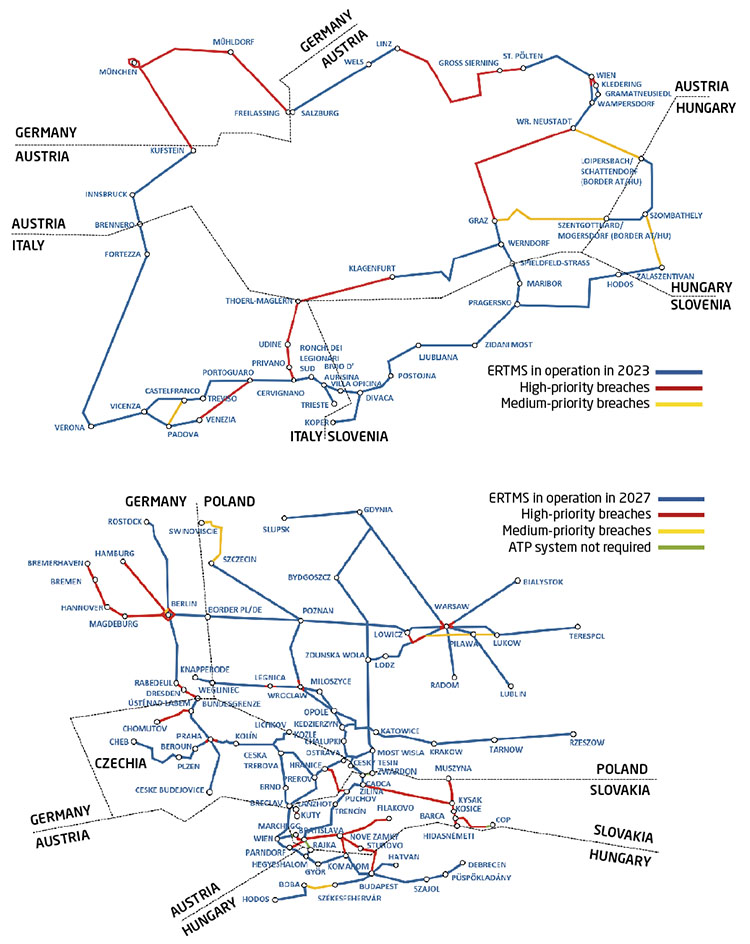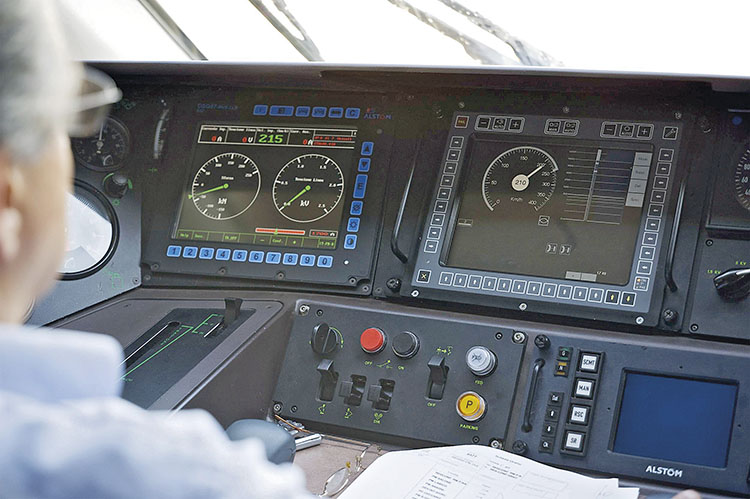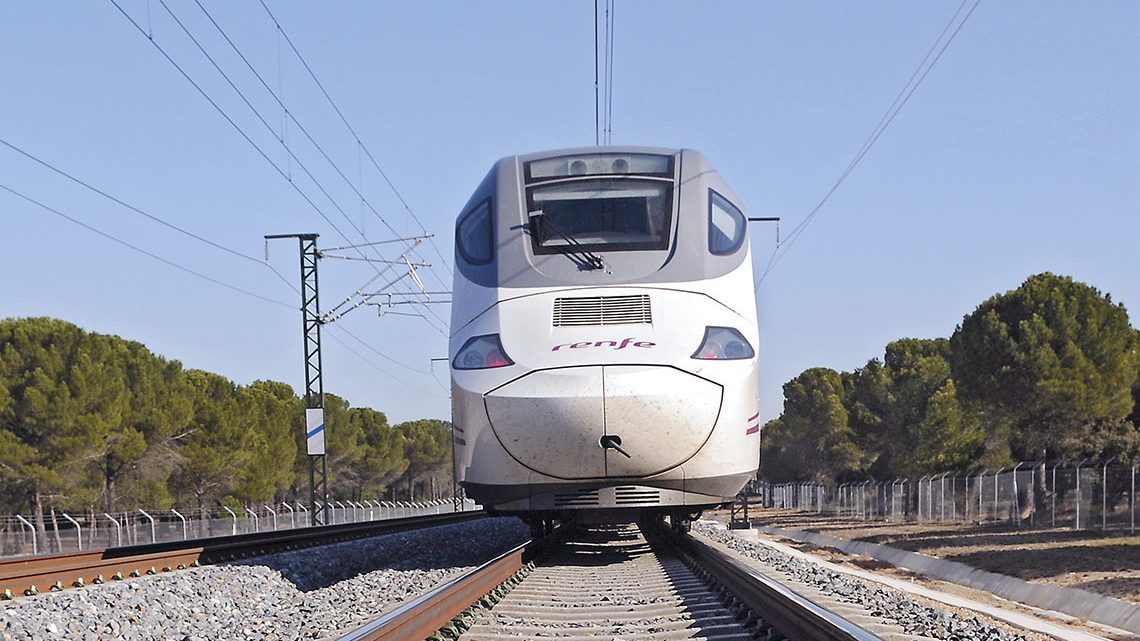Across the Member States of the European Union there are more than 20 national rail signalling and control systems, called ‘Class B systems’ by the Commission. For long-distance railway transport, this means that whenever a train crosses from one country to another, the locomotive, driver and even the whole train may have to be changed. The solution is a common system that allows trains to operate with the same rail “language” on every network, something called ‘interoperability’. In 1989, this principle led to the birth of ERTMS (European Rail Traffic Management System) with the support of the European Commission for its implementation as the sole system.
On behalf of the European Commission, during the period 2014-2021 Ineco has been coordinating the implementation of the system along nine European rail corridors, totalling 51,000 kilometres. It is a huge and complex industrial project that involves national and European rail regulators, operators, infrastructure managers, manufacturers, stakeholders along the corridors, and others, and requires the monitoring of ground-based and on-board systems.

PRINCIPAL NETWORK OF MAJOR EUROPEAN CORRIDORS. On behalf of the European Commission over the period 2014-2021, Ineco has been coordinating the implementation of the ERTMS system along nine European rail corridors, totalling 51,000 kilometres. / MAP_EUROPEAN COMMISSION
A specific study on on-board systems was carried out by the consulting firm PWC and Ineco and submitted to the European Commission in October by Ineco. The starting point is that widespread implementation of ERTMS is key to achieving the goal of railway interoperability that will make it possible to create a “single European railway area” similar to the “single European sky” for air transport. But adapting the infrastructure is not on its own enough; train fleets also have to be adapted to make the system efficient.
In April 2020, 12% (6,120 km) of European corridors were working with ETCS and 63% with GSM-R. Of the 15,682 kilometres due to come into service in 2023 under the European deployment plan for ERTMS, 5,906 kilometres (38%) have been contracted and 78% of what was planned to have been achieved by the end of 2019 has been completed. Almost all of the high-speed networks in Italy and Spain are monitored and protected by ERTMS. The system allows trains in commercial service to run at speeds of up to 350 km/h. Extensive parts of the networks in the Netherlands, Czechia and Belgium, as well as Switzerland outside the EU, have been outfitted. ETCS is also used to control freight trains arriving at Europe’s biggest port, Rotterdam. Europe’s longest tunnel under the Alps, the St. Gotthard tunnel in Switzerland, 57 kilometres long, has Level 2 ERTMS. The system has also been in service for a number of years in commuter services, such as those in Madrid (see IT46).
ERTMS-equipped trains will be key to the continued operation of international freight routes
The report found that, despite this progress, there is still much work to be done to achieve sufficient implementation of ERTMS to deliver a truly interoperable rail network: implementation continues to be patchy and most Member States have chosen not to do it now, but rather in the long term. And while there are rail companies, operators and manufacturers that have chosen to outfit their fleets with ERTMS, the report notes that, in most cases, this is only done when required due to the characteristics of the network, because of the technical, financial and economic risks that must be assumed. Fewer than 4,000 trains have been equipped with the system in Europe. Over the last five years, approximately 5,000 new vehicles have been acquired in Europe. However, only 900 of those new vehicles are equipped with ERTMS. The lack of equipped vehicles consequently stops rail infrastructure operators from deriving the maximum benefit from the ERTMS system that has already been deployed.
The principal aim of the study is therefore to assess the impact of further trackside deployment of ERTMS on operators, mainly for international freight transport. In particular, the study assesses the efficiency of the installation of ERTMS to significantly expand the routes available to locomotives, and efficiency in terms of the simplification of signalling equipment in vehicles.
To do that, three major European networks with high volumes of international freight traffic and extensive ERTMS installation were selected: Network 1, made up of the Netherlands, Belgium, Luxembourg, western Germany, eastern France, Switzerland and north-western Italy; Network 2, made up of north-eastern Italy, Austria, western Hungary, Slovenia and southern Germany; and Network 3, which encompasses north-eastern Germany, Poland, Czechia, Slovakia, Hungary and Austria (Vienna node only).

Comparison of full ERTMS structure and Class B systems. / IMAGE_INECO
Principal conclusions
From the point of view of ERTMS implementation, the report confirms that over the next few years, significant use of ERTMS in rail operations will be achieved. In Network 1, the number of kilometres not equipped with ERTMS will fall from 70% in 2020 to just 15% in 2025.
From the point of view of infrastructure managers, the report recommends that national deployment strategies include the considerations that would enable them to prioritise specific sections. That prioritisation would have an enormous impact on European freight operators. For example, in 2025 a locomotive equipped with ERTMS alone will be able to cover the distance between the port of Rotterdam and northern Italy, more than 1,000 kilometres, if ERTMS deployment on just 75 kilometres of the route can be sped up.
Accelerated, coordinated deployment of ERTMS can generate direct benefits on all the networks studied
From the point of view of rail companies, the report confirms that over the next few years, ERTMS could substitute Class B systems in the fleet, rather than being an additional system. In addition, to cover international freight transport, the report concludes that all new locomotives should be equipped with ERTMS and recommends consideration of ERTMS installation in the existing fleet. ERTMS-equipped trains will be key to the continued operation of international freight routes. The issue of connectivity is common to the three networks assessed, albeit to varying degrees. The lack of ERTMS-equipped locomotives would lead to the loss of 100% of the international routes in Network 2 by 2030, 86% on Network 1 and 50% on Network 3.
Although there are good reasons to support strategies for on-board implementation of ERTMS, a transition period with one or two Class B systems alongside ERTMS is inevitable. Based on its analysis of international traffic as well as the deployment and the characteristics of the system, the report concludes that there is no single Class B system that can be considered the most effective one to work alongside ERTMS on the whole European fleet. It is clear that each operator needs its own individual strategy, depending mainly on the country it is based in.

For the purposes of the study, three major European networks with high volumes of international freight traffic and extensive installation of ERTMS were selected. In the images, two maps of Network 2 and 3; this last encompasses north-eastern Germany, Poland, Czechia, Slovakia, Hungary and Austria (Vienna node only). / MAPS_INECO
To implement those strategies, they need to be supported by technical analyses of the principal risks that the deployment of ERTMS poses to the fleet. The report focuses on a review of national technical rules and the interface between ERTMS and Class B.
The main recommendations to mitigate the risks posed by those aspects of the systems to deployment include:
- Encourage the use and stability of existing Class B products when different providers have relevant solutions. This allows effort and resources to be concentrated on the deployment of ERTMS, creating efficiencies across Europe, rather than on further developing Class B. Also, further development of Class B using the standard interface (or STM) does not guarantee ready connectivity with ERTMS systems.
- To grow international traffic, dual-standard solutions should not be allowed for Class B if there is no available alternative.
- Broaden transparency requirements in information concerning national technical rules for all parties involved, including the Member States and infrastructure managers, as well as providers and rail companies. This would enable Europe-wide mechanisms to be updated and improved to avoid the adoption of unexpected national rules that could have significant effects on interoperability in international transport.
The report contains a review of different scenarios for each of the selected networks, to assess the potential financial effects of alternative ERTMS implementation strategies on infrastructure managers and international rail freight businesses. This analysis, comparing cumulative long-term (2020-2055) cash flows in three possible scenarios, confirms that coordinated and accelerated deployment of ERTMS could bring direct benefits –for infrastructure managers and for rail companies– in each of the three networks in the study.
What is a ERTMS?

ERTMS (European Rail Traffic Management System), and its control and protection subsystem, ETCS (European Train Control System), is an Automatic Train Protection (ATP) system that provides a high level of safety.
It consists of the exchange of information between trains and infrastructure and is based on on-board signalling and continuous speed monitoring. It can be deployed on different levels of application, which differ in the way that the information is transmitted: burst transmission from track to train for Level 1 and continuous two-way transmission in Levels 2 and 3.
It is made up of two basic subsystems, one on-board and the other trackside, that are connected via interoperable channels. The on-board ETCS equipment is the European Vital Computer (EVC) and the trackside ETCS equipment is essentially the groups of Eurobalises and LEU (Lineside Electronic Unit), associated with Level 1 communications, and the Radio Block Centre (RBC), associated with Level 2.
ERTMS can also make use of GSM-R (Global System for Mobile Communications–Railway), which allows data and voice transmission between the driver and control centre.
The implementation of ERTMS brings with it different improvements in railway operations, such as interoperability of different types of train in different infrastructures and increased safety and capacity. This capacity is calculated based on the number of trains with established characteristics that can travel on a railway line or network during a certain period of time. In addition, the benefit of ERTMS in railway digitisation programmes has been demonstrated through its deployment in the modernisation processes of numerous railway networks at international level.






